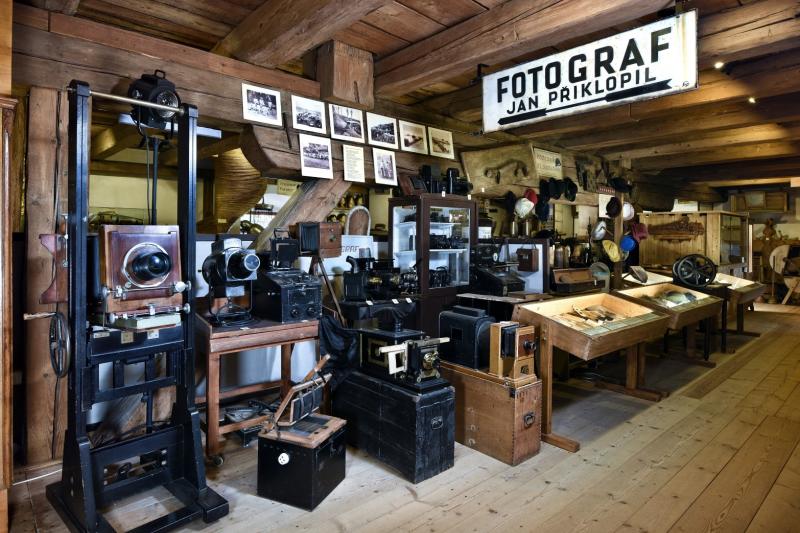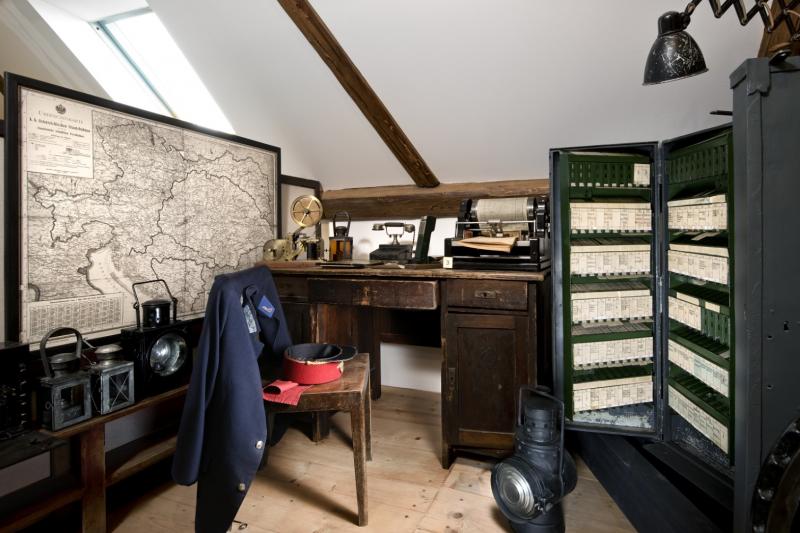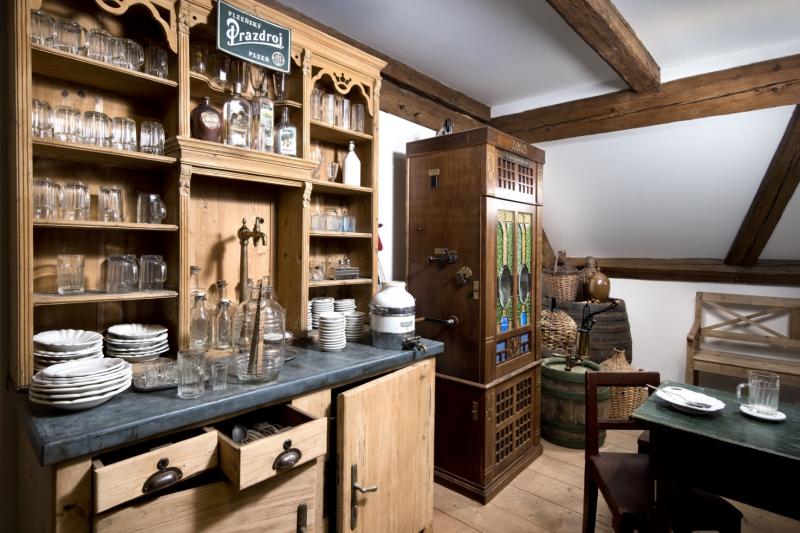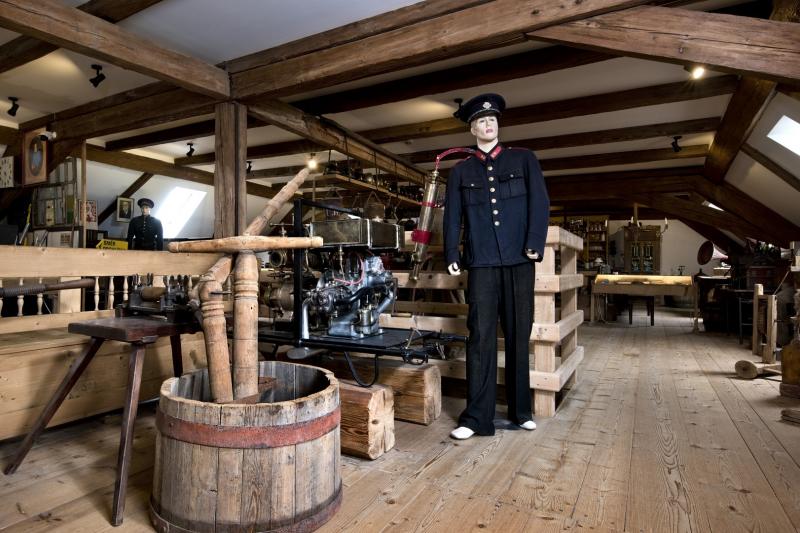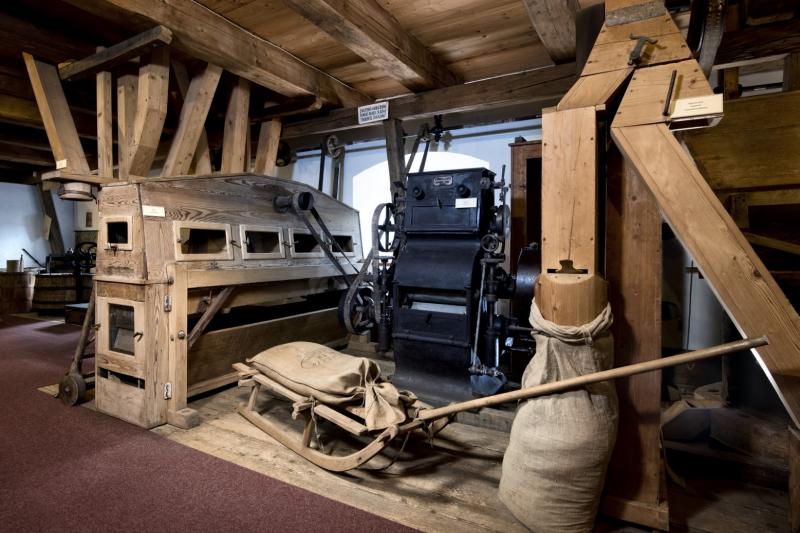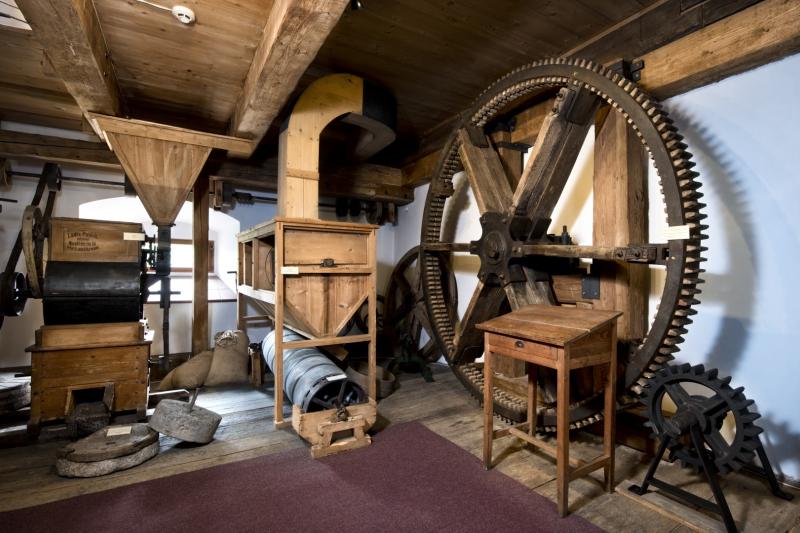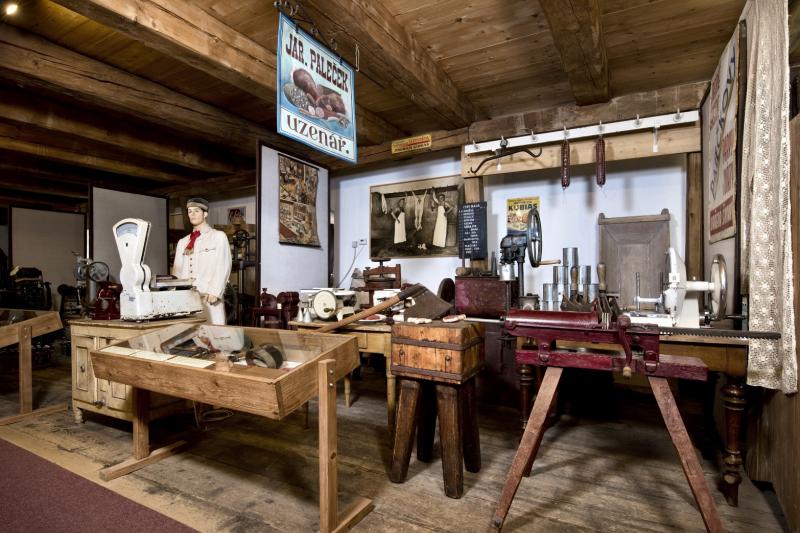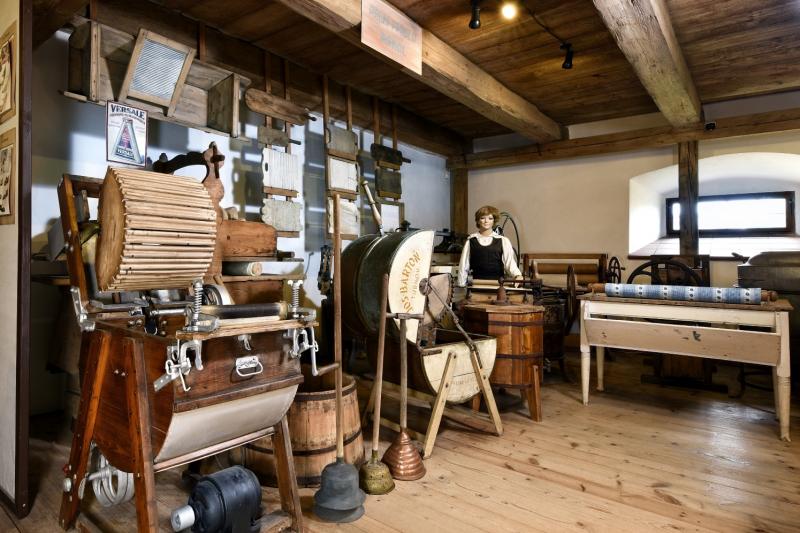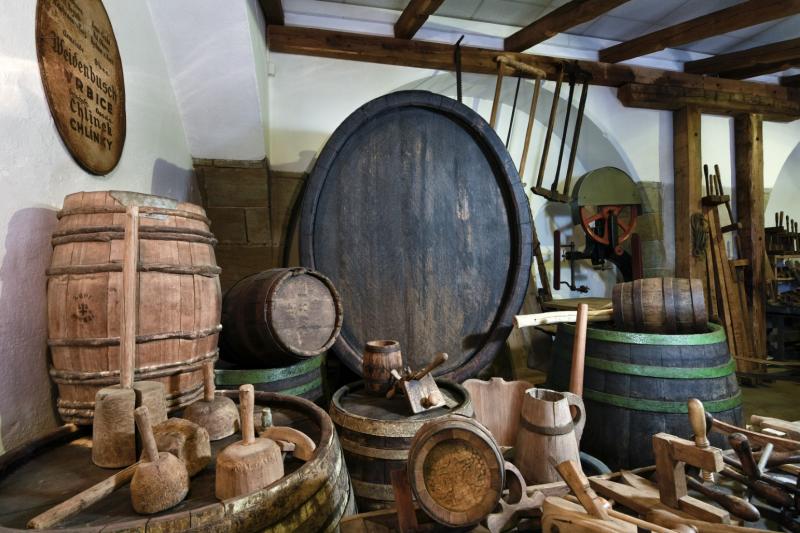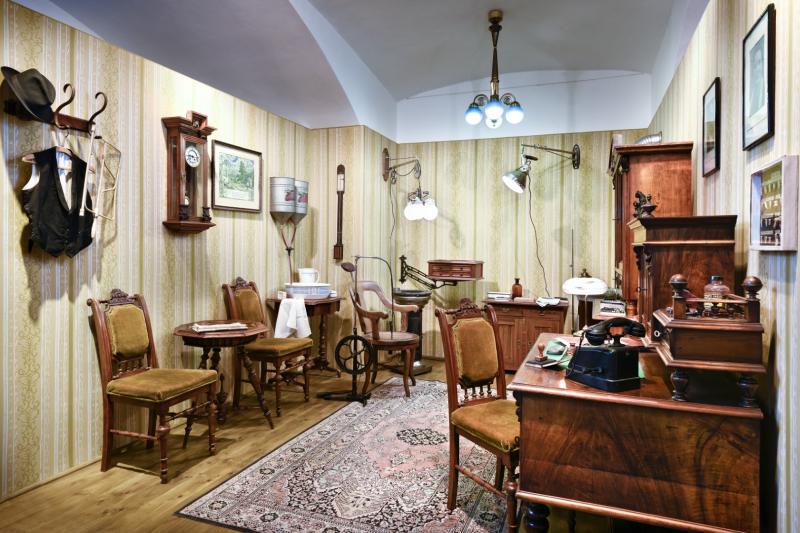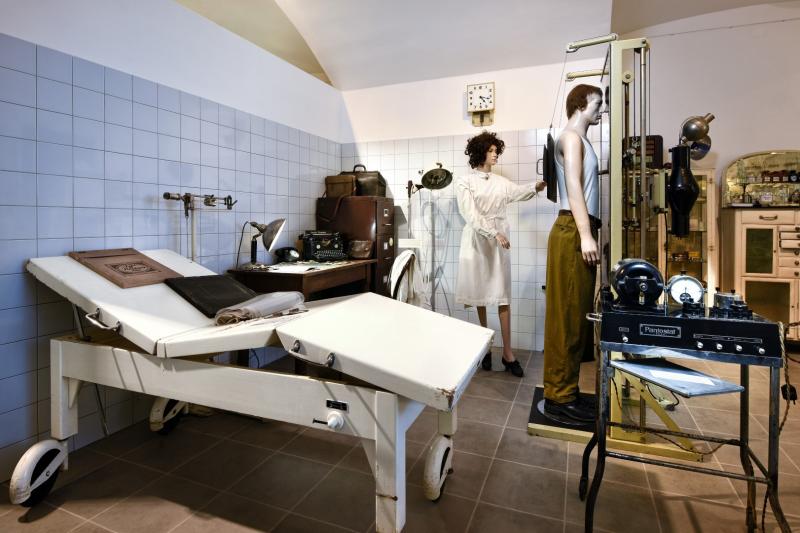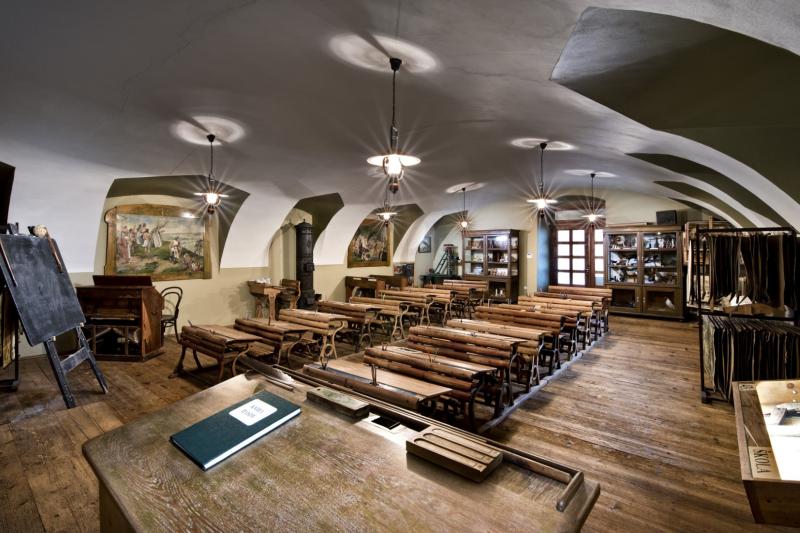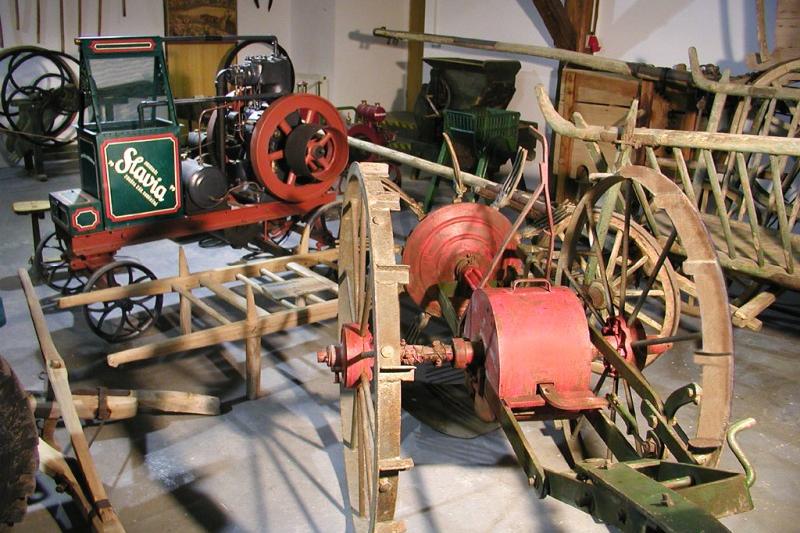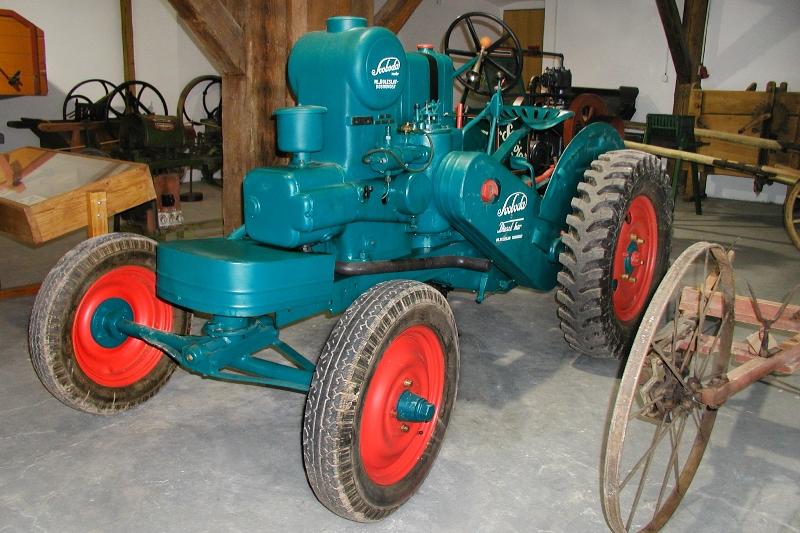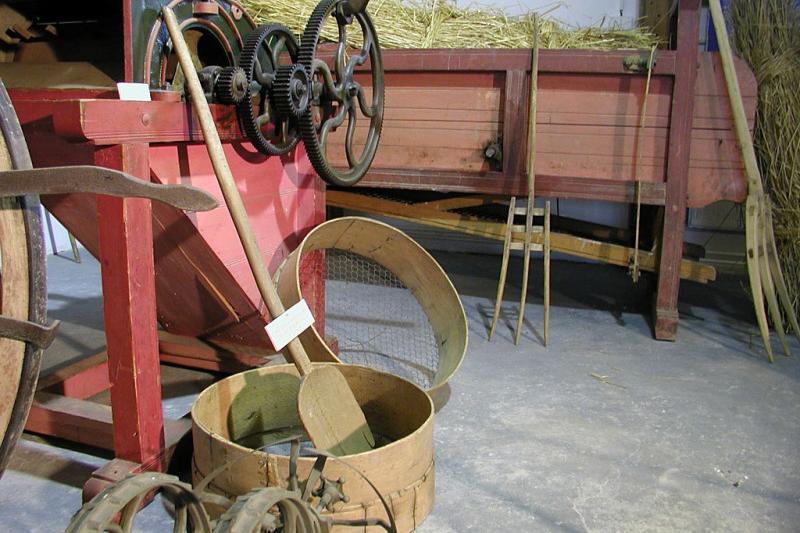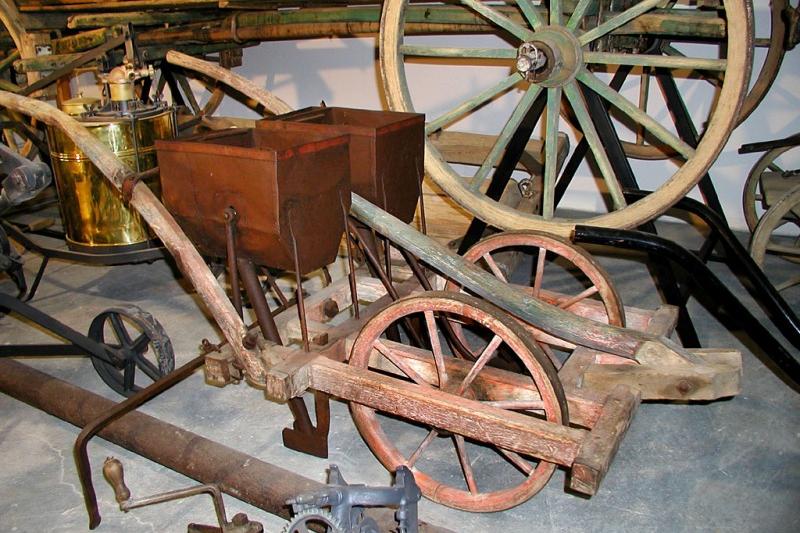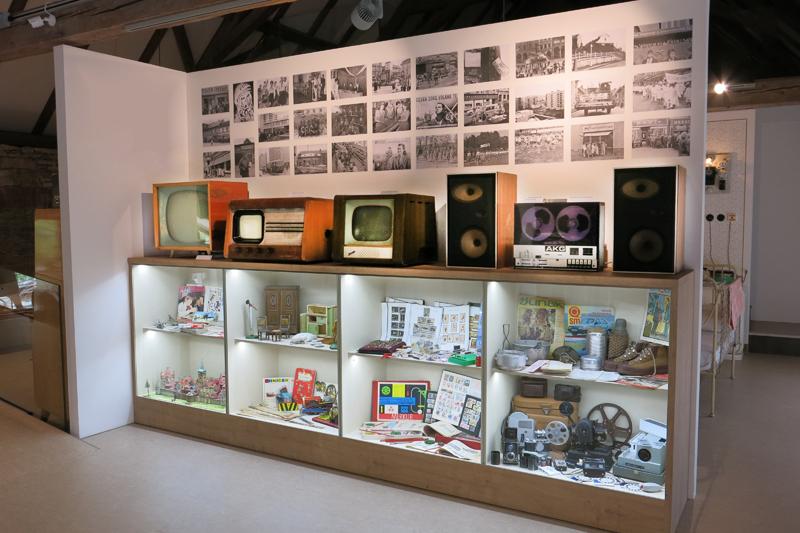- ROUTE A - Exposition 'na sypce'
-
Apart from other things on the first floor, you can learn about soap production, washing and mangling clothes and there is a unique exposition of paramentory, a watchmaker, a wood-carver, a shoemaker, a barber, a wig-maker, a merchant and a tailor. The most popular exhibit on this floor is a unique carved mechanical open-air museum of crafts made just for the Craft Museum.
On the second floor there are especially crafts dealing with food production, but there is also a sitting as it used to be and as they used to live more than 100 years ago. Dominant room is taken up with miller's trade, including a part of a water wheel, bakery, a confectioner, a butcher, cheese, butter and carbonated water production and a beekeeper. A special wooden switch-back attracts to a lift on this floor, which was used to drop sacks down to a lower floor.
The third floor introduces apart from equipment of a country pub and fire-fighter's techniques as well as a gun maker, a policeman, a railwayman, a brush maker, cloth weaving, a saddle maker, rope production and pressing of linseed oil and a black coat.
In our exposition you can see a unique moving open-air museum of crafts with 25 carved craftsmen, who show their craft. This open-air museum was made to order of our museum by a woodcutter from Trebechovice. Before its realization we took a photo of individual machines and machinery, they were designed, somewhere it was necessary to find out the concrete movement either a machine or a craftsman. It was also important to make a drive and gearing mechanisms so that you can see the cog wheels. The body of the open-air museum is made of pinewood, scenery, machines and figures of lime wood, cog wheels of gearing of beech wood. The craftsmen show 15 crafts.
- ROUTE B - Mechanical workshops
-
The locksmith used to have the smith's technical knowledge and he basically had his workshop equipment as well. The most frequent product of locksmiths' was a door-lock or a chest-lock. Locks used to be made of iron, without a spring, and they already included a well enough developed mechanism against an easy opening. Locksmiths decorated keys and even tin lock covers.
The Tinsmith. In times when production of thin metallic sheets (plates) was a very difficult job, which was carried out by forging, the assortment of plate products was very narrow. Food containers were made of copper and later brass plate, which was tin plated. As far as iron containers were concerned, plate as well as containers were manufactured by blacksmiths. Goods were sold in own shops or they delivered to stores. For households they produced lamps, candlesticks, lanterns, boxes, pots, lids, plates, frying pans, various pots for bathrooms, toilets and laundries. For municipal as well as village builders they made various troughs, waste pipes, gutters and sheet metal coverings.
A smith heats iron, hammers it, cuts it, and pierces it (in the contrary to a locksmith who files, cuts, and bores it when cold). Unlike other crafts bound by guild regulations, smiths were allowed to establish their shops wherever necessary. Smiths in the country were jacks-of-all-trades (they also used to be healers and vets). Smiths in the country were jacks-of-all-trades (they also used to be healers and vets). The work of smiths marked as "white smith's work" meant the production of various tools, kitchenware, and decorative work (e.g. bars, railings, gate and door mounting, or knockers). "Black smith's work" included horse-forging and cart-hooping. The hearth with forge bellows, a hammer anvil, tongs and hammers were the basic tools the smith used for his work.
Then you can see the workshops of stone-mason, brick-maker, stove-fitter.
Production of cement goods
Exhibits come from the firm Barták from Polná u Jihlavy, where they were borrowed from the local museum. On the tables, there are preparations and forms for pressing and production of cement tiles, which were used as a roofing material. The display also shows hooves, forms and preparations for production of cement troughs for stock feeding etc.
Town harware and general store Ladislav Hubený Jásenná (the village of Jásenná lies between Jaroměř and Opočno)
The store equipment was retained in the original house but moved from room to room. Aside from the original furniture, great deal of authentic goods and packing material has been preserved. The store was run until the year 1950. In the shelves is original goods: stationary and office supplies, fancy goods, candles, Christmas ornaments, matches, soaps, wire wool, grindstones, scrub brushes, scythes, rakes, powder dyes, oils, resin oils, spare parts for kerosene lamps, spirit stoves, flower pots, pots and pans, pot lids, hemp bags, nails, coffee bags, grocery bags,roles of paper for making paper cones, toy figures for children, automatic cashier machine National and a small wooden calculator on the counter do not originate from the store in Jesenná. They were added from the museum depository. - ROUTE B - Sawmill department
-
In the year 2007, construction of sawmill department begun by an excavation pit for the cast-iron and wooden saw-mill machine. Gradually, springing stones were built for shifting shafts, wall columns for frame of the elevated floor and positioning of the saw-mill machine gadgetry.
The first saw-mill machine (on the left) was acquired in January 2005 from Sloupnice by Ústí nad Orlicí where it was used from the year 1976. It originated from a sawmill department at Trojanov's mill in Slatina nad Zdobnicí around the year 1900. Saw-mill machine has a wooden construction with its own actuator for log rollers. The frame contains five saw-blades. The saw-mill machine is actuated by its original engine. The second saw-mill machine (in the middle) originates, together with the third saw-mill machine, from the flour and saw mill in Kunvald, house number 211, acquired in April 2006. A reference about this mill is dated from around the year 1836. The saw-mill machine has a wooden construction; the pit for the crank-shaft of the single-bladed saw is 2 meters deep. Height total of the saw-mill machine frame together with the crank-shaft is 6 meters, the length of the frame that holds the log is 8.5 meters. The cog gear, which shifts the frame with the log, has been made new by the staff of the Craft Museum because the original cog gear has been substantially damaged. The original cog gear is leant against adjacent wall. A single saw blade is placed within the frame of the saw-mill machine. Oscillation count is about 86 per minute. Disassembly, relocation, repair work, and re-installation of the single-bladed saw-mill machine was very time consuming, technically difficult, and labor intensive. The third saw-mill machine comes also from the mill in Kunvald and it was acquired in 2006. It was constructed by Jaroslav Červinka from Týniště nad Orlicí in 1921. The saw-mill machine is solid cast-iron, type Orlice 50, and enables vertical placement of up to 11 saw blades. The base of the cast-iron saw-mill machine is 2.2. meters deep with a volume of 6.5m^3. Oscillation count is about 193 per minute. The weight of the saw-mill machine is 2.8 tons. The carts on the rail come from a mill from Dolní Libchavy. Both saw-mill machines are actuated by their original engines with a power of 16kW. Both saw-mill machines are described in the Book of Technological Landmarks in the Bohemia, Moravia, and Silesia (Technické památky v Čechách, na Moravě a ve Slezku).
Cart-wtight: We often find cart-wrights in the same guild as smiths, because they worked on the same work. Timber needed by the cart-wright had to be faultless, solid and tough. Cart-wrights manufactured carts, handcarts, wheelbarrows, ploughs, harrows, skis, and other useful items. Later they also produced different wooden frames (for carts and even for sleighs), axles, and wheels. The cooper manufactured common wooden dishes of "white" soft wood - baths, wash-tubs, barrels, tubs, sinks, pails, buckets, churns, watering-cans, etc., the barrel was used also as a measure. The barrel-maker made barrels, vats, and tuns of "black" solid oak and beech wood. The name barrel-maker ceased to be used in the half of the 19th century and both crafts were joined. The decline of these crafts was caused by factory metal production and the use of metal vessels in households.
The cooper manufactured common wooden dishes of "white" soft wood - baths, wash-tubs, barrels, tubs, sinks, pails, buckets, churns, watering-cans, etc., the barrel was used also as a measure. The barrel-maker made barrels, vats, and tuns of "black" solid oak and beech wood. The name barrel-maker ceased to be used in the half of the 19th century and both crafts were joined. The decline of these crafts was caused by factory metal production and the use of metal vessels in households.
The shingler makes roofing called shingles. On the thicker lengthwise side, there is a groove. On the other side, the plank is planed into an edge. A shingle is cut out of dry spruce chocks, its plane is done by a drawknife, and a groove is planed. - ROUTE C - Vehicle depot
-
The depot is located in the courtyard in a different place than its two previous wooden versions. This brick building had been standing only on stone pillars; the walls were added between the pillars only after the war when the depot served as a storage and garage of the UNRA west aid vehicles. A unique execution of a wooden roof frame of the depot is a state protected landmark. (Currently, the roof frame is covered with a plasterboard ceiling).
In 2009, an exhibition of historic vehicles was set up in this part of the building. Visitors can thus see a stunningly decorated funeral carriage, smaller Victoria feudal carriages that were predominantly used by ladies but also by common feuds. There are also road carts: one in the original condition, the other one is renovated. These vehicles were then made popular among master porters, and later among farmers. A classical rack wagon, that can be rarely seen nowadays, used to be used when bringing down crop and hay. Even a few historic fire fighting vehicles are a part of the display. The most interesting is a carriage fire-engine from 1926, bought by the countess from the POHLED Chateau to protect her manor. The fire-engine was made in the R. A. Smekal, Praha Smíchov, Slatiňany - Čechy na Hané factory with the product number of 1638 and the MARS stable engine. The fire-engine has been preserved in the original condition in the fire squad in Šachotín. Only Pohled signs were covered with a thick paint. Furthermore, there are fire-engines with a hand pump to be operated by four persons. One of them was acquired on 6/10/1896 by an unknown fire squad and is one of the oldest ones in Moravia. It was manufactured in E. C. FLADER SORGENTHAL b/Pressnitz, Bohmen.
A very interesting vehicle is a beautiful sleigh for winter travels. Roads used to be always full of snow in the past so travelling by sleigh was common from this area even to Prague. A sleigh with a seat for a coachman in the rear behind the carriage body served in near České Petrovice to transport midwives where they were needed. The last coachman remembered that several times during a night when the sleigh had got overturned due to a fast ride, he had been looking for the midwife in the dark in a deep snow and could not find her. The smallest carriages are for children. They are small sleighs and prams from various periods. The oldest ones are a Baroque upholstered sleigh and a tricycle. - ROUTE D - Dental and gynaecological surgery
-
The ‘dental and gynaecological surgery’ exhibition displays two different dental surgeries, an X-ray machine, a unique gynaecological surgery from 1924 and an operating theatre from 1960.
The first is a dentist’s surgery in a town apartment. The surgery includes one of the first drills, powered by a pedal. Dental surgery was far less pleasant then than it is today, drilling lasted far longer, and you can forget about water cooling. The second dentist’s surgery is from 1940 – 1960 and includes a working electric drill which was brought to Czechoslovakia after the war from America. And so brave visitors are welcome to get their teeth drilled by the guide.
In the next section, visitors can view an X-ray room and gynaecological surgery. This unique well-preserved equipment comes from Doctor Václav Pulter’s surgery in Smiřice, from the year 1924. The wooden gynaecological couch and some of the instruments look pretty horrific today. Also worth noting is the ‘Mountain Sun’ folding bed and X-ray machine – this too looks completely different today.
The last section of the exhibition looks at surgery, where you can see an operating table, an artificial pneumothorax machine, old sterilising equipment and rehabilitative aids. There are also a wide range of electrotherapy and massage instruments, a very popular medical aid at the time. There is also a Violet Ray electrotherapy device, which was featured in the Czech film, Postřižiny (Cutting It Short).
The exhibition features a touch screen which you can use to view period pictures of surgeries, lithography of a medical theme and look into historical medical books.
The exhibition shows you medicine which is somewhat different to that we know today, and every visitor will be sure to enjoy the experience. - ROUTE E - School classroom
-
The word 'school' is of a Greek origin and meant free time that was possible to use to work mentally - that signified relaxation and was a privilege of civic classes of the ancient society. Being a teacher was one of the tasks of clergy. Priests used to found schools and were taking care of education of higher classes.
Our classroom is equipped with old benches from the village of Hrušová and a teacher's desk from a local school in Kunčice at Letohrad where Mr. Kněžek, who compiled the oldest memoirs of the inhabitants of Kunčice, was teaching.
In schools the following subjects were taught: religion, reading, writing, language, geography and history, natural science and science (today's physics and chemistry), mathematics together with simple accounting, geometry and manual geometric drawing, neat handwriting, singing, craftwork, physical exercise.
In the classroom there are also folk costumes from the regions of Podorlicko, Kyjov, Hlinsko and Svitavy - ROUTE F - Agriculture
-
In ancient times the main occupation of people was ensuring basic life needs. And it was living in the first place. Firstly, men picked what they had found in nature; later on they learnt how to grow plants themselves. As the time passed by, in our land work was concentrated on managed pieces of land near the feudal farms, rectory fields, near larger agricultural estates and houses and lands and small fields of small peasants. Then feudal nobility, clergy and commons lived upon the results of work on this land.
Servants were employed on big peasant estates - they were part of a family. The servants consisted of stable boys (they looked after horses, used a plough and a horse team), maidens (they looked after cattle and did the housework), herdsmen, ploughboys (they did easier work in the farmyard like pasture or grooming horses), shepherds and goose-girls (children were often busy, too). The hind supervised servants on the feudal farms and at big farmers. His woman called a field-woman took control of maidens, looked after feeding and chores over the cattle and cleanness of cowsheds. Stable boys were taken up into the service on the New Year s Day and left after the elapse of a year on the Boxing Day (December, 26th). Maidens arrived on January on Epiphany (January, 6th) and left the farm after a year on the New Year s Day.
Here in the exposition, you can see equipment from the beginning of mass land cultivation with development of mechanized work till 1948. Agricultural fields were formed in our regions by gradual wood clearing, whose wood was needed for building up of dwellings. A great part of woods was also used in the surrounding glass works as firing in the Orlicke Mountains. After burning out the stumps, whose ashes served as the first fertilizers, land cultivation could start.
In the exposition there are the oldest cow and bovine yokes, ploughs called "ruchadla", sowing machines, trashing-machines, stationary engines, a binder maker, wind grinders called "fofry", tractor Svoboda 12, carriages, a digger, cutting machines and other agriculture machines. - ROUTE H - Retro
- ROUTE K - Historic nativity scenes
-
More than 100 historic nativity scenes
Duration (approximately)
| ROUTE A | craft exposition on three floors of granary | individual - without guide: 30 - 60 min. ordered group with guide: 60 min. |
|---|---|---|
| ROUTE B | mechanical workshops | only with guide: 50 min. |
| ROUTE C | vehicle depot | only with guide: 15 - 20 min. |
| ROUTE D | dental and gynaecological surgery | only with guide: 25 - 30 min. |
| ROUTE E | school classroom | only with guide: 15 - 20 min. |
| ROUTE F | agriculture | only with guide: 15 - 20 min. |
| ROUTE H | retro exposition | only with guide: 40 min. |
| ROUTE K | historic nativity scenes | individual - without guide: 30 - 45 min. |
Disciplined dogs/cats on leash are allowed in the museum.
